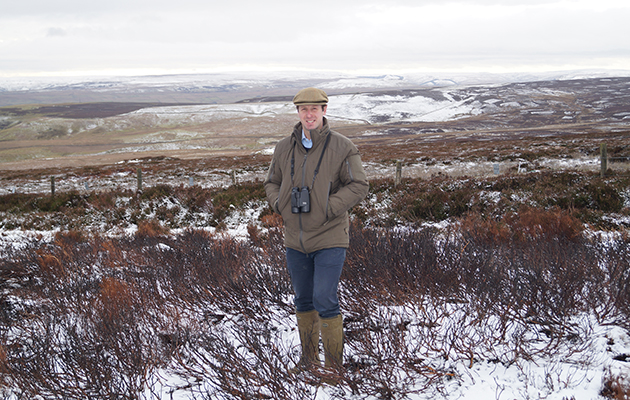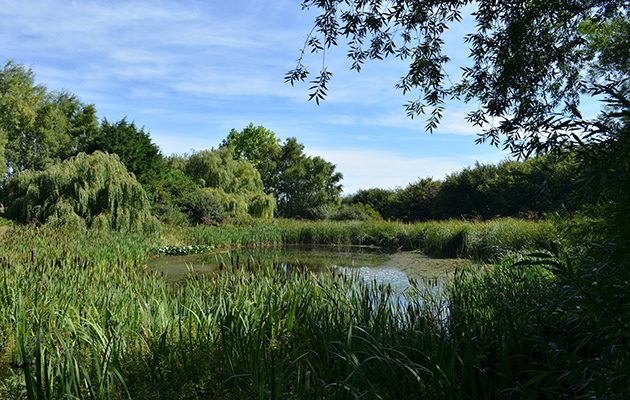Stories of farmers successfully restoring wildlife on their land make a powerful case for Government funding in exchange for public benefits post Brexit
The achievements of the RSBP’s nature reserves are well known, while the excellent conservation work happening on private land and individual farms and estates is often forgotten. Joe Dimbleby tells the stories of conservation farmers and their successes, and explains why this work offers a powerful case for Government funding post Brexit.
For more on the future opportunities for farming, read our farming column on post-Brexit agricultural policy: the opportunity of a lifetime.
CONSERVATION FARMERS
I recently travelled across the UK to interview farmers and gamekeepers for a new collection of case studies published by the Game & Wildlife Conservation Trust (GWCT). These “working conservationists” are engaged in a range of different businesses, from Mark Chattey farming beef on 284 acres in Devon to Tom Orde-Powlett managing conservation projects on the family’s 12,500-acre estate in Wensleydale, but all share common ground in their passion for nature. The GWCT champions such individuals because the future of British wildlife depends on them and others taking their lead.

Beef farmer James Mulleneux, who is in a Natural England-funded Higher Level Stewardship scheme.
The RSPB rightly states that, “Nature reserves and protected areas are a good start. But on their own, they are not enough to deal with these challenges.” The issue is one of scale. When you consider that farmland covers around 17.2m hectares, or 70% of the UK, whereas RSPB and Wildlife Trusts nature reserves combined cover less than 250,000 hectares, the vital importance of private stewardship becomes clear.
ENRICHING THE LANDSCAPE
Individuals can achieve extraordinary things in relatively small spaces. A shining example is Count Konrad Goess-Saurau, whose 2,000-acre Temple Farm estate on the Wiltshire Downs was devoid of nature when he arrived. He said, “When I first came it was desolate and so windy I didn’t get out of the car. There was nothing you’d expect from an English estate, not so much as a mouse.” Now, after planting more than a million trees, digging 11 ponds and planting 23 miles of hedgerow he has created a wildlife haven. The farming is profitable and though the conservation measures might mean a slight reduction in revenue, for Goess-Saurau the enriched landscape more than compensates.
Temple is an example of where red-listed species are bucking the trend. Current approaches to conservation are failing to reverse the general pattern of wildlife decline as the bleak picture painted in the latest State of Nature 2016 report makes clear. Public support for wildlife conservation is strong, as demonstrated by the fact that the combined annual income of the 50 conservation organisations that produced the report is in excess of £1bn and they can boast more than eight million members between them, yet we have lost more than half our wildlife since 1970 and one in 10 British species is threatened with extinction. The public knows all about RSPB nature reserves thanks to the BBC granting them primetime slots on Springwatch, but much less about the wonderful conservation work that happens on private land, on individual farms and estates. We aim to change that with these case studies and thank The Field and its readers for helping to promote them and tip the balance back a little.

Charlie Mellor, headkeeper on the Duke of Norfolk’s estate, inspects a sweep net.
Another outstanding case is the Duke of Norfolk’s Peppering Partridge Project in West Sussex, where red-listed skylarks have gone up by 57%, linnets by 94%, yellowhammers up 20% and lapwings up 71%. Readers will have read past coverage in The Field of the project winning the Purdey Awards for Shooting and Conservation and its wild partridge shoot, run by headkeeper Charlie Mellor, underpins this extraordinary restoration. But the project is also one of the best examples of public-funded, agri-environment schemes delivering the goods. Estate manager Peter Knight recently entered Natural England’s new Higher Tier Stewardship Scheme after he came to the end of a 10-year HLS agreement and manages 20 different options alongside a highly complex commercial rotation. It takes hours of planning and a huge commitment on the part of the Duke, Knight, Mellor and the whole team, but they have proved it possible to combine profitable intensive cereal production with successful conservation.
The need for agri-environment schemes to work in practice as well as theory was a common concern among the working conservationists I interviewed. The farmers’ stories all contained an instance where regulation proved inflexible to the detriment of the conservation work. One example is Alastair Salvesen, who farms 2,500 in Midlothian. Whitburgh Farms is a study
area for the Partridge Project led by the GWCT and Salvesen has built up a wild grey population from nil to 400 pairs, with a shootable surplus for the first time last season. However, a rule forbidding the use of glyphosate in grass margins risks hampering his efforts at partridge restoration. He said, “We had to abandon the five-year agri-environment scheme where you had to top the thistles instead of spraying, because if you cut them in the breeding season, you risk killing the partridges and after that it is too late, the seed has spread on the wind.” The lesson from such stories is that where our wildlife is concerned, sitting back and doing nothing is no longer an option. A risk-averse approach to conservation can itself be harmful and stifle innovation.

A harvest mouse nest on a farm in the Selborne Landscape Partnership.
The farmers featured in the collection are experts at producing biodiversity in the field margins and less productive bits of farmland. Beef farmer James Mulleneux, who is in a Natural England-funded Higher Level Stewardship scheme, including an option for arable reversion to grassland, said, “In the old days we used to let grassland grow to a seed-head, so you had different levels of sward. There were nettles and piles of vegetation lying around. The way we manage the landscape has changed hugely. These days it is manicured with machinery and I have to make a conscious effort not to cut everything back in the margins.” However, Mulleneux was keen to stress that success will not be achieved by trying to turn back the clock. It should be a case of applying the latest research to maximise space for nature alongside more efficient farming at the core.
Several of the working conservationists are in landscape-scale conservation partnerships and all commented on the value of working with teams on the farm, neighbours, local communities and the public at large. There is increasing recognition that individual species recovery depends on the health and integration of large-scale eco-systems.
Another working conservationist, Kate Faulkner, represents the family farm on the Selborne Landscape Partnership, which was one of the first Farmer Clusters, initiated by the GWCT and Natural England. For one of its projects, the cluster chose to improve habitat for harvest mice, inspired by the famous naturalist Gilbert White, who lived in nearby Selborne and first identified harvest mice as a separate species. This kind of joined-up approach with community engagement has the potential to create what are, in effect, huge new nature reserves across the country at relatively low cost.

A huge commitment by the Duke of Norfolk’s team has successfully combined cereal production and conservation.
As our ever-shrinking countryside is increasingly contested, spaces will have to work harder by performing several different functions simultaneously and it’s right that farmers and landowners should be paid to deliver a wide range of public goods. Tom Orde-Powlett’s many conservation projects at Bolton Castle estate include helping to protect breeding curlew, which are in dramatic decline elsewhere. In addition to the conservation of some of our rarest bird species, the grouse moor run by Orde-Powlett’s father, Lord Bolton, offers public access to a wildlife rich habitat, provides employment, supports the local economy and traditional rural communities, offers grazing for sheep farmers, traps carbon through peat restoration and helps avert flooding, all at relatively little cost to the taxpayer. Orde-Powlett said, “If we can show we can hold up one million litres of water here and delay a peak flow down in York for three hours, that’s going to reduce the extent of flood damage and you can start to put a price on that.”
In his introduction to the case studies collection, former Defra Minister of State Sir Jim Paice writes: “We must never forget that farmers’ main aim is to produce food and to make a living from doing so. If our farmers are to survive outside the protection of the CAP and against cheaper imports then they must be properly rewarded for the environmental
measures they provide. It is expensive not just in terms of direct costs but in foregoing crop income and in management time. So whatever schemes the Government brings forward must recognise that.”

Projects at Bolton Castle are helping to protect the curlew, numbers of which are in decline elsewhere.
Currently, signs from Government are encouraging. Defra Secretary of State Michael Gove wrote in his foreword to the collection that, “when we leave the Common Agricultural Policy we will be able to follow evidence like this with even greater ambition – we will be able to incentivise the kinds of collaboration and innovation that bring the transformative, landscape-scale changes outlined in our 25 Year Environment Plan.”
GAMEKEEPING TECHNIQUES
The GWCT’s guiding principle of a “working conservation” is that wildlife can thrive alongside other land uses. Early on, the organisation recognised that gamekeepers were the champions of this multiple-outcomes approach as farming modernised to meet the post-war demand for food. It studied carefully how they began to use their range of techniques, from trapping to growing small strips of cover crop, to maintain their bird numbers without hindering farm production. Today, these gamekeeping techniques are valuable conservation tools because they make space for wildlife in a working countryside and it is no accident that very often there are shoots on the farms where wildlife declines are being reversed.

The grouse moor run by Tom Orde-Powlett’s father, Lord Bolton, offers a rich wildlife habitat as well as support to the local economy and rural communities.
These case studies show that given financial support and encouragement as well as freedom from red tape and fear of fines or getting things wrong, land managers can deliver both food production and countryside restoration. In every case specialist knowledge is a key ingredient of success and backed by scientific research, GWCT advisers provide practical advice on how to manage land with a view to improving biodiversity. Few organisations have the same degree of trust from land managers developed over generations and with ever greater pressure on the countryside to increase food production, provide space for housing and deliver a range of public benefits, the survival of our wildlife will depend on that trust.
Without exception, the working conservationists talk about the importance of “your heart being in it” and the collection shows the power of private individuals working together to make a difference. Former hill farmer David Thomas, who is helping to restore grouse and a range of upland birds to heather moorland in Powys, spends 18 hours a day on the hill but to him it’s worth it. He said, “We have managed to increase curlew broods on the hill, which I am delighted by. When the birds call on the moor at the end of February, it’s the first sign of spring and I stop to admire the sound.”
To join the GWCT – or to order a copy of Working Conservationists – call 01425 651024 or go to: www.gwct.org.uk





